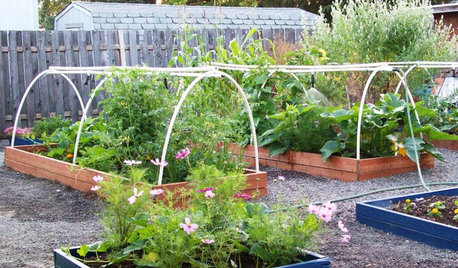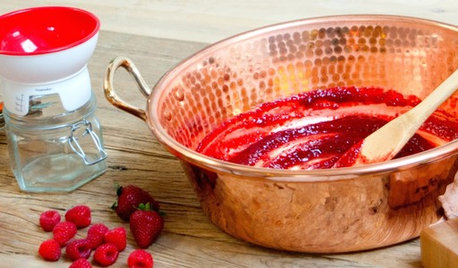Phosphates and Fruit Production
In the "I'm Stubborn" thread started by considerwhy on June 27, 2009, Herman2 observed the following regarding triple phosphates:
"Hi Guys:I have not used it this year,but used it last year on some second year container trees,and I noticed that very soon after using it I got fruits on Black Ischia,Zingarella,and Sal's Corleone,that were eather small or too young to produce fruits,and they did.
Very few people in the world can make a Black Ischia fruit in Third year,so I think The T Phosphates had something to do with it.....
and
I would apply it one time early in the Spring to get a good start.
It is more usefull to bust the weak,fig mosaic affected figs to get ahead."
2 weeks after the thread was posted I went in search of Triple Phyosphate and ended up with "Super Phosphate" which is only 0-20-0 instead of 0-46-0. I gave a healthy dose of it to everything that would hold still.
It is a month later and I have an explosion of small fruit on EVERYTHING including a little 12" Mission. The little devils are popping out almost faster than I can pick them off. In addition, I have an explosion of new leaf growth both on the limbs and, in many cases, on the lower trunk of many trees. Also, as Herman2 observed, the new leaves on plants that were heavily affected with FMV appear completely normal.
Amazing stuff. I just wish I had used it in the Spring in stead of mid-summer, in which case I might have had some ripe fruit by now. Hopefully, this will help other newbies.
C.J.
Comments (24)
xgrndpounder
14 years agolast modified: 9 years agoHAHA
I love the "I gave a healthy dose of it to everything that would hold still"
Happy gardening
Cecil
jenia
Original Author14 years agolast modified: 9 years agoCecil,
The spouse and the cats know to run when I pull out the fertilizer and the measuring cups.
C.J.
Related Professionals
Chattanooga Landscape Architects & Landscape Designers · Clark Landscape Contractors · Coeur d'Alene Landscape Contractors · Columbine Landscape Contractors · Fort Worth Landscape Contractors · Wilton Landscape Contractors · Lauderdale Lakes Landscape Contractors · Suisun City Landscape Contractors · Cave Spring Decks, Patios & Outdoor Enclosures · Albemarle Decks, Patios & Outdoor Enclosures · Cary Decks, Patios & Outdoor Enclosures · Issaquah Decks, Patios & Outdoor Enclosures · Kearns Decks, Patios & Outdoor Enclosures · Charleston Fence Contractors · Charlotte Fence Contractorsxgrndpounder
14 years agolast modified: 9 years agoHAHA
C.J. that sounds like around here! I'm still ROFL
I love it!
Best regards
Ceciltapla (mid-Michigan, USDA z5b-6a)
14 years agolast modified: 9 years agoI'm sorry to say this, Jenia, but I'm going to note that it would probably be impossible, through known science, to trace the effects you described to phosphates as the cause.
In the first, Liebig's Law of the Minimum dispels the myth that any more than adequate to luxury levels of phosphate in the soil will have beneficial effect on the plant's vitality and/or yields, but that excess CAN have a negative effect. Plants are encoded with a certain amount of genetic vigor, and no matter how much phosphate, other fertilizers, sunlight, etc., you provide, the plant will never grow at beyond that potential. It cannot.
When plants fruit is determined first by the age/stage of the wood (it must be in mature or reproductive phase) and second by other cultural conditions - mainly photoperiod. Unless P was present in soils at deficiency levels, supplying additional amounts will not improve growth. Neither does it make the wood age or change phase any faster.
Figs use about 6 times more N than P, so supplying P at any more than about 1/6 the rate of N is a waste. The plant cannot use it, and it adds unnecessarily to the level of TDS (total dissolved solids) and EC (electrical conductivity), which makes it more difficult for the plant to take up water AND all the nutrients dissolved in that water. High levels of P are also great at interfering with the uptake of Fe and Mn, so I would caution other readers against expecting to see one person's anecdotal observations to be manifest their own plants. Virtually all commonly used soluble formulations contain more than enough P to sustain levels in the adequacy range whenever N is also being supplied in adequate amounts. If it's not, then it would be N that would be the limiting factor, and no amount of P supplied would improve growth/fruiting.
Al
dieseler
14 years agolast modified: 9 years agoTapla
would Nitrogen in large amount help a fig with FMV?
or would it be similar to your explanation above with P .cazimere
14 years agolast modified: 9 years agoCJ, I agree with Hermans observations. I applied 12-55-6 to 8 month old plants with no figs and within a week 7 out of 8 plants had figs forming. Coincidence,i think not. They are starting another burst of fig production now. Sometimes you need to think outside the box : )
tapla (mid-Michigan, USDA z5b-6a)
14 years agolast modified: 9 years agoDiesler - Fig mosaic virus is usually transmitted by fig mites or infected cuttings. After symptoms are apparent, there is no practical control. Good nutrition including N in the appropriate range (adequate to luxury levels) can help minimize its effects. So yes, Too much N would have deleterious effects, just as too much P would, though the symptoms would be different. Since there is another thread running now where the OP intends to supply elevated levels of K, I'll just say the same is true of elevated K levels as elevated N or P levels.
Certainly some of you have come across Liebig's Law of the Minimum before. First, there are 6 factors that affect plant growth and yield; they are: air water light temperature soil or media nutrients. Liebig's Law of Limiting Factors states the most deficient factor limits plant growth and increasing the supply of non-limiting factors will not increase plant growth. Only by increasing most deficient factor will the plant growth increase. There is also an optimum combination of the factors and increasing them, individually or in various combinations, can lead to toxicity for the plant.
Caz - SO - what is the basis of your agreement? WHY do you agree? Someone thinking outside of the box does not change known science, no matter how hard you wish. The luxury of an opinion often carries with it the inconvenience of reason, so I'm interested in what you have to offer. If you think that because two people make the same observation that it can't be coincidence, or even the power of suggestion at work, you've made a serious error in logic.Al
xgrndpounder
14 years agolast modified: 9 years agoIf I ain't learn't but one thing here, it would be to not have a battle of wits with tapla (Al) because I would be darn near unarmed....HAHA
Cecil
danab_z9_la
14 years agolast modified: 9 years agoI think that it is quite possible that Herman's and Cazimere's potting mix was deficient in P and that's why they saw the difference. I'm sure that a little triple phosphate would supply more than enough P. The superphosphate was probably way overkill and could definitely be harmful to plants grown in a container.
I grow citrus trees in the ground in South Louisiana. It is recommended that citrus trees in La. get fertilized with a Nitrogen fertilizer(ammonium nitrate) at the end of May. This is done so that the tree will grow new branches. It is on those new branches that "clusters" rather than "single" flowers will form in the following spring. (Clusters of flowers form on year old wood, while single flowers will form on any current year growth). This extra nitrogen fertilization will significantly improve plant yields for next year's crop.......by increasing the numbers of flowers that will form next year. However, usually the soil around those citrus trees will already have enough P and K from the early spring fertilization of the trees with 8-8-8 or 13-13-13 to make the extra Nitrogen applied at the end of May very effective.
Dan
tapla (mid-Michigan, USDA z5b-6a)
14 years agolast modified: 9 years agoDan - any 1:1:1 fertilizer is a high P and K, low N fertilizer. Generally, because N is the most used nutrient, we supply nutrients as a fraction of N. If we were supplying N based on 1 part of P, we would be supplying 3 parts of N. (Plants use 6 times more N than P, but P in fertilizers is reported as P2O5 and must be factored by .43 to come up with the ACTUAL amount of P supplied. Thus, even though it appears that 1:1:1 fertilizers like the ones you listed supply 6 times more P than plants use, after the .43 factor, it is actually closer to 3 times. Still enough though, to say that 1:1:1 fertilizers are high-P fertilizers and supply much more P than plants can use if you are fertilizing at appropriate N levels).
The same is true for K. Plants use about 1.7X as much N as K. After factoring (because K is reported as K2O, and we must apply a .83 factor to determine how much K is actually in a fertilizer we can see that 1:1:1 fertilizers have about twice as much K as needed when fertilizing to supply adequate N.
The inverse of what I said is that 1:1:1 fertilizers are low in N, compared to their P and K content, so it wouldn't be surprising that a plant would benefit from the extra supply of NH4NO3. I would point out however, that supplying any amount of N beyond a plant's needs will not make it grow better or more, and it won't increase lateral breaks. If N is DEFICIENT in the soil, adding N will only allow the tree to return to NORMAL growth, not grow at anything beyond its genetic potential.
Another way of looking at it is to say that if N wasn't deficient in the soil, the added N would do nothing in the way of stimulating anything beyond normal growth.
Somewhere along the way, we curiously began to look at fertilizers as miraculous assemblages of growth drugs, and started interpreting the restorative (of normal growth) effect of fertilizer as stimulation beyond what a normal growth rate would be if all nutrients were adequately present in soils to begin with. In couplet with the hope for the miracle tonic is the idea that because a little seems to help, Âmore must be better'. ItÂs no small wonder that we come away with the idea that there are Âmiracle concoctions out there and often end up applying them copiously and holding more hope than is reasonable.
Al
elder
14 years agolast modified: 9 years agoThere are good reasons to believe in the personal observations of jenia, Herman, and Cazimere that additional phosphorous will increase fruit yields:
1. Fig growers in Japan use different combinations of fertilizer for different times of the year in order to increase early growth, and later fruiting. These people really know what they are doing, they have studied it closely.
2. A well-known manufacturer of fertilizer produces an all around formula of NPK at 3-1-2, and a formula for increased flowering (fruiting comes after flowering) of NPK at 1-2-1.
3. Several years ago I was having a conversation with a man who raised lemons in Florida, and he stated in no uncertain terms that if a tree was not producing he would give it an extra shot of phosphorous. Perhaps anecdotal evidence, but probably a valid observation.
4. Haven't we all seen instances where the application of high amounts of N (nitrogen) has caused rank vegetative growth, providing it was below toxic levels.
It seems perfectly logical that the percentages of NPK are NOT set at any given formula - a plant will grow given either 3-1-2 or 1-2-1 - but it is important that all three be available below toxic levels. Where N is at the high end it accelerates vegetative growth, where P is at the high end it accelerates flowering and fruiting, and I think K increases root growth.danab_z9_la
14 years agolast modified: 9 years agoAl,
I fully understand what you are saying.
My citrus trees do respond quite well to the application of nitrogen in May. Citrus in our area grows in three annual spurts. There is an early season flush of new growth followed by a period of root growth. Then a second flush of new growth followed by another stage of root growth. Then a final third flush of new growth followed by yet another stage of root growth. Citrus farmers and LSU horticulturists have discovered that for optimal citrus fruit production, it is essential to supply additional nitrogen in May.
Dan
tapla (mid-Michigan, USDA z5b-6a)
14 years agolast modified: 9 years agoI don't think there ARE good reasons to accept anecdote over proven science.
My point is that large doses of P, or any other nutrient you might supply in dose ranges higher than adequate to luxury will not 'force' the plant to grow better or change the way it was genetically programmed to grow. In fact, concentrations above needed rates will detract from the plant's ability to grow at genetic potential.
The only time it makes sense to use a high P fertilizer for trees in the ground is when P is deficient AND N levels are adequate or better. It never makes sense to use a high-P fertilizer for plants in containers. That the people Elder mentioned report increased growth because of P applications is no indication that ultra-high levels stimulate super growth. It's far more reasonable, and science absolutely supports that if the addition of P makes a considerable difference, it was because P was DEFICIENT in the first place and its addition simply allowed the plant to return to NORMAL, not super-normal growth.
I'm not sure why we should believe that the Japanese have studied tree growth any more closely than we have, or that they somehow know better what they are doing than Americans. I'm sure they don't have a corner on the arboriculture info market. I too, have talked to people who have said many, many things about plants in no uncertain terms that could not possibly be so. People once were certain the earth was flat, but science wins out over anecdote every time, unless we can unprove what's known. So what a few others say isn't enough for me to abandon known science, which is why we're having this discussion.
Excess nitrogen doesn't change the actual amount of growth (growth is measured in the increase of biomass), but it does change how that growth appears, and high P levels don't stimulate additional blooms or fruit, so no, it doesn't seem logical to me. To some degree, you can change the energy sink to blooms/fruit by supplying P at adequate levels, but reducing the N delivery. This slows vegetative growth and the tree will recognize the fruit as a stronger sink and direct energy there, but again, ultra-high levels of P cannot possibly cause fruiting beyond what is normal for the tree.
Greenhouses use a nutrient manipulation strategy similar to what you suggest (but their reasoning is different) in bringing bedding plants that are bushy, compact, and sexually mature (in bloom) to market. They fertilize at ADEQUATE levels of all nutrients (including P and K) except N. That is how high P fertilizers SHOULD be used, but P levels are soo high in most we cannot supply adequate N without supplying as much as 33 times (10-52-10 supplies about 33 times MORE P than the plant can use. This dramatically raised EC and TDS, makes it more difficult for the plant to absorb water and ALL the other nutrients dissolved in water, and very often creates antagonistic deficiencies of Fe and Mn, which high doses of P are wont to do) more P than necessary and with only detrimental effect.
Al
benny111
14 years agolast modified: 9 years agoAl -tapla
I must say I totally enjoy reading your postings, nice to see just the pure facts brought to the table.thanks
xgrndpounder
14 years agolast modified: 9 years agoHAHA.........I'm gonna behave........Yep, that is what i'm doink!
danab_z9_la
14 years agolast modified: 9 years agoFact is.....many soils are deficient in one of the vial elements and the average grower does not know which one is lacking or deficient. Emperical data is scientific too.....emperical data has shown that in many cases the application of moderate amounts of N, P, K is beneficial to the plant even though one or two of these elements might be in excess.
I too would never add certain fertilizers to potted plants because of the risk of raising the Electical Conductivity and Total Dissolved Solids too high. Too high a TDS content of soil moisture causes a reverse osmosis effect that affects root uptake on moisture.....which I agree with you is bad for the plant.
Dan
tapla (mid-Michigan, USDA z5b-6a)
14 years agolast modified: 9 years agoVery true, Dan. Plants do "take what they need and leave the rest" (words from an old song), and while under some conditions there may be little harm in having more P in soils than is needed, there is SOME, the effects of which I already pointed out (and with other caveats to follow) but there is also no advantage to having too much P or any other nutrient in the soil.
The caveats are: No harm unless the extra P raises the TDS and EC of the soil solution above favorable levels (very easy to do with high-P fertilizers and phosphates), lest they inhibit normal osmosis. Let's say you need to keep the soil solution strength at 1,000 ppm TDS. If you're fertilizing at 700 ppm with just P alone, there is no way you can supply all the other nutrients and combine them with the solutes already in the soil solution and remain at a favorable level. What sense does it make to supply so much P that you cannot supply adequate N & K + secondaries and minors w/o raising the TDS of the soil solution so high you see plasmolysis?
The second half of the caveats is that not only is a high level of P in soils likely to create either plasmolysis or deficiencies of other nutrients because you must keep their levels down to allow for the high P levels, but you have to consider the effects of high P levels on the uptake of Fe and Mn.
Those points are very secondary to the fact that you cannot force plants to grow at anything beyond their genetic potential. IF plants are experiencing a P Or any other nutrient) deficiency, you can restore normal growth by adding more P, but you cannot create super-growth by following a 'more is better' philosophy.
Likely scenario after fertilizing with high P levels: Since "you added fertilizer" it should be a month or 2 weeks before it's needed again, but wait. The fertilizer was low in N (compared to its P content) or you used phosphates. The plant yellows from a lack of N, or the P interferes with Fe/Mn uptake, which causes yellowing. You fertilize again with more P or more likely, a high-P fertilizer because you like it. This exacerbates the condition because you can't supply enough N in relation to P, or the extra P makes the antagonistic Fe/Mn deficiency worse, as it also drives pH up. You see the yellowing is worse, so you grab more high-P fertilizer ...... when all you had to do is lay off the P and use a fertilizer that supplies nutrients in a favorable ratio across the board - like any 3:1:2 (or 2:1:2 if you wish to reduce vegetative growth) you find anywhere.
Al
bonsaist
14 years agolast modified: 9 years agoI've always used a high P fertilizer with no abvious results.
This year I did the right thing and used a slow release high N fertilizer. The results are so abvious, I started cuttings this march, these cuttings are now 5 ft tall and some with figs already. This was due to the right fertilizer, the right container size and the right soil mix.
I agree with Al, I have a proof that it works.Bass
danab_z9_la
14 years agolast modified: 9 years agoI don't use triple phosphates or superphosphates and never would use them under any circumstances. Al gives a good explanation why other fertilizers may be preferable.
But, I have proof too what works for me. My starts in gallon containers get fertilized with Miracle Grow. My spares which may stay in a larger container for a longer period of time will get fertilized with a time release fertilizer such as Osmocote. By design, there should never be any TDS or EC issues with time released fertilizers. If I grew all of my trees in containers, a time release fertilizer would be my choice. I would apply it early in the season. If my trees needed a bit more fertilizer later in the season I would use a Miracle Grow type product where I have more control on dosage rate. I would not want to have excess fertilizer availability in my containers going into the fall. Late season fertilization encourages tender growth that is easily winter killed.
For my in ground fig trees I fertilize them with SMALL amounts of 8-8-8 and give them plenty of water in the early part of the growing season. I stop applying fertilizer whenever I see a flush of new growth on my trees. In my yard consistent watering is more important than fertilizer. I have Mississippi river delta soil in my yard and Fe and Mn availability appears not to be a problem as I have not seen any adverse yellowing.
Dan
oxankle
14 years agolast modified: 9 years agoI do not want to start a cat fight here, but I would like someone to explain this to me.
We have anecdotal evidence of increase hardiness and fruit prodution with the application of phosphates.
Al tells us as best I recall, that plants use roughly six times more nitrogen than phosphorus.
Today I happened to be in Lowes and I looked at the analysis on Miracle grow and the bloom and fruit formulation for the same product.
The ordinary MG that most of us use is a 3/2/1 mix of NPK.
The bloom and fruit formulation is 1/2/1, twice as much phosphate as either nitrogen or potassium.Al; how does this jibe with your earlier comments? Do the fertilizer manufacturers make any assumptions about what is already available to the plant?
tapla (mid-Michigan, USDA z5b-6a)
14 years agolast modified: 9 years agoFirst, let me say that people are actually very poor observers, especially when it comes to things they're growing. I include myself in that group, though I think I have trained/taught myself over the years to look deeper when the cause effect relationship I THINK I'm seeing doesn't square with science.
I think in this case, grower A applies a healthy dose of nutrient X, & since the plant responds favorably, ASSUMES that large doses of nutrient X will make everyone's plants grow better. Enter anecdote. Grower A spreads the word, Grower B, C, D, E listen & try grower A's plan. One of the growers, grower E also sees improvement, and agrees with grower A and also spreads the word. Soon, there's a movement toward massive doses of nutrient X because it's a designer drug for figs.
The science of the whole thing is pretty simple. If you add a single nutrient to the soil and the plant shows any significant response, the nutrient was deficient to begin with. So an observer that has a little more knowledge of physiology says, "Hmmm, I gave the plant nutrient X and it responded, so it must have been deficient." The same observer also KNOWS that applying more nutrient X than the plant can use is going to be counterproductive, and that you simply cannot force a plant to grow any better than it's inherent genetic potential.
When we think of vigor, we must think of genetics and an organism's ability to resist strain. OTOH, when we think of vitality, we must consider a plant's ability to grow under the conditions in which it finds itself - to cope with what it has. Vigor is capacity or potential, and vitality is the dynamic - what the organism actually does with what it has.
In order for a plant to grow with good vitality, things don't need to be perfect, but to realize fully it's potential vitality AND grow at it's genetic level of vigor, things do. From a nutritional (only) perspective, we can have things 3 ways:
1) Too little of one or more essential nutrients = reduced vitality and no chance to grow at its potential vigor.
2) All nutrients available in adequate amounts and no excess of singular or multiple nutrients = a chance at growing at it's potential vigor.
3) Too much of one or more essential nutrients = reduced vitality and no chance to grow at its potential vigor.
Ox: Figs are no exception to other plants in that they use NPK in VERY close to a 10:1.5:7 ratio. If we want to reduce that so we can compare it to a 3:1:2 ratio, we can multiply everything by .3. We see then, that figs use NPK at a ratio very close to 3:.45:2.1. Note here that the N used is roughly 6 times that of P. This is true for almost ALL plants. If we look closer, we can see that even 3:1:2 ratio fertilizers actually supply 2x the P that plants need. 1:1:1 fertilizers (after factoring because P is reported as P2O5) supply 2.75x more P than plants need.
Fertilizer companies don't make too many assumptions. They're in business to sell you product, to make money. If they can dupe buyers into believing that giant doses of P will bring a bounty of blooms, they're certainly not above it.
Among growers, you often find common belief that high-P fertilizers are a requirement for promotion of root growth and/or flowering/fruiting. Fertilizer blends like 15-30-15, and even 10-52-10 are sold under names that imply that you actually NEED these formulas for plants to bloom well and to produce strong roots or fruit. While anecdotal evidence abounds, there is no scientific evidence to be found that shows any need for such products. Ive mentioned in other posts on the forums that high-P fertilizers are actually a historical carry-over from when it was common for plants to be started in outdoor soil beds, the soil in which was usually still quite cold at sowing time. Both the solubility of P and plants ability to take it up are reduced in cold soils, so it was reasoned that fertilizing with high levels of P insured that at least some would be available during periods of growth in chilled soils.
Al
oxankle
14 years agolast modified: 9 years agoAl, many of us use Miracle Grow, so in effect we are over applying Phosphate. My recollection is that the phosphate fertilizers do not leach away as quickly as nitrogen fertilizers. This in effect means that if we water until a pot is draining we are leaching away nitrogen faster than phosphate.
Two questions: One, am I correct in that the phosphates do not leach away as quickly as nitrogen and so builds up in the potting mix?
Second question: If we water to the point that our pots drain, would it be wise at some point to simply provide nitrogen alone? (I am not about to soil-test all those pots!)
Ox
















tapla (mid-Michigan, USDA z5b-6a)